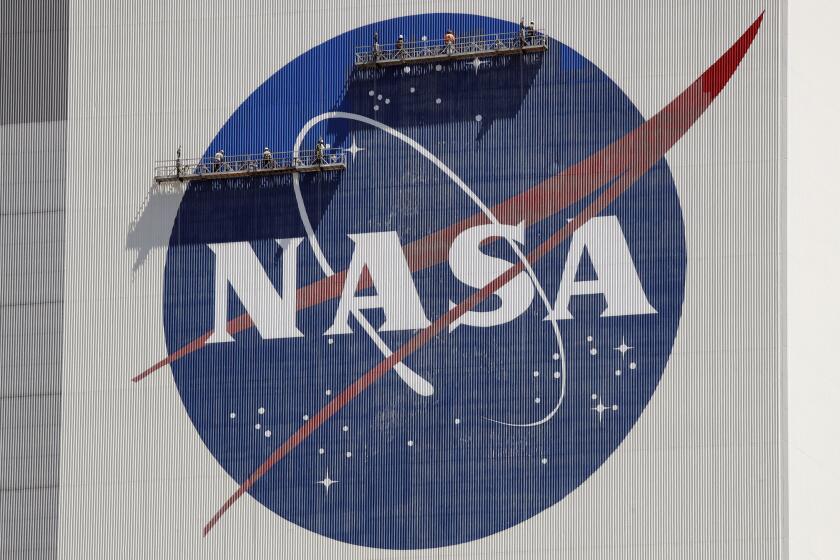Rest in Space : Company Plans to Become First to Launch Cremated Remains Into Orbit
- Share via
Death traditionally takes the remains of the departed to many places: under the ground, inside crypts, into the ocean or perhaps, in the form of ashes, spread along a favorite golf course or mountain vista.
Now, outer space can be added to the list.
This fall, a Texas company hopes to be the first to provide transportation for human remains into orbit hundreds of miles above the Earth.
Celestis Inc. of Houston, formed by three space industry veterans, will offer “burials” in space for less than $5,000 per person. If all goes as planned, the first human ashes will hitch a ride on a Pegasus booster scheduled to rocket a Spanish satellite into orbit in late September.
On that first Celestis mission will be the ashes of up to 30 people, including the recently deceased LSD philosopher Timothy Leary, “Star Trek” creator Gene Roddenberry and space colony advocate Gerald O’Neill.
“This is a service for people who always dreamed of going into space,” said Celestis founder Charlie Chafer, “but couldn’t during the time they were alive.”
Chafer is quick to add that the service provides only a “symbolic” space burial, for several reasons:
* Only a small portion of the cremated remains will make the flight. The lipstick-sized capsule designed by Celestis for each individual will carry a maximum weight of seven grams, or about a quarter of an ounce. “That’s about seven Sweet ‘n Low packages,” Chafer said. A cremated adult usually weighs about five to seven pounds, so the capsules will contain less than 1% of an individual body.
* The ashes themselves will never float free in space, unless something goes wrong. The Celestis capsules are designed to hold the remains securely, each capsule sealed with its own little O-ring.
* Nor will the capsules drift off in their own twinkling orbits. They will remain attached to the last stage of the booster rocket snug in a honeycomb-like container.
* Even this last waltz on the shores of the cosmos will be temporary. Within 1 1/2 to 10 years, the rocket booster’s orbit will decay to the point where it slides back into the atmosphere and burns up from the heat of reentry, Celestis officials say--cremating the remains a second time.
*
“It’s not what some people imagine when they talk about a burial in space,” Chafer said. “The people who select our service are interested in a space memorial. It’s symbolic of what was important to them while they were living.”
This was the case with Leary, who died of cancer May 31 at age 75.
“Timothy believed that space represented freedom,” said Carol Rosin, a friend of the late psychologist. “Vast, limitless, he loved all that.”
Chafer’s company was not the first to propose this kind of service. In 1985 a Florida-based firm called Celestis Group (which has no connection with the Houston company, except in name) announced plans to send a rocket into space carrying the ashes of more than 10,000 people.
But the group ran into regulatory problems. Florida state law requires that money paid in advance for burial or cremation services must be held in a trust until the services are administered.
Celestis Group officials balked at this, saying they needed to spend the money on hardware and prelaunch expenses. “They made the state attorney general mad, and then the state really went after them,” Chafer said.
In 1986, Florida took Celestis Group to court, charging it with operating an unlicensed cemetery. The state said that under its laws, the firm’s “cemetery” had to consist of at least 15 contiguous acres with access by paved road, even if it was in space.
In addition, astronomers complained that the Celestis Group was planning to set the capsules adrift to float freely through space, creating glittering space debris that would interfere with their observations.
“By the time all this was straightened out,” Chafer said, “two of three founders of Celestis Group had died and the company could not recover.”
Chafer said that two years ago he was looking for new opportunities when he and two colleagues started Celestis with funding provided by private investors. The new venture borrowed the former company’s name, “because we liked it so much,” Chafer said, but had a completely different business plan.
Instead of taking on the huge expense of an entire launch, Celestis opted for hitching rides on other commercial ventures. After its first payload of up to 30 capsules, Celestis hopes to expand to a 150-capsule launch.
The new Celestis bought space on launches planned by the Virginia-based Orbital Sciences Corp., the largest of the commercial spaceflight companies.
*
If all goes according to plan, the first Celestis payload will be aboard a Pegasus rocket to be launched from a high-flying, specially equipped L-1011 jet.
Because the capsules will remain attached to the second stage of the rocket while it is in orbit, Celestis hopes that it has headed off astronomers’ complaints about littering the heavens.
Chafer said the company now has 15 reservations for the first flight. Roddenberry’s widow, actress Majel Barrett--known to “Star Trek” fans as the voice of the computer on the starship Enterprise and as the mother of Deanna Troi--made arrangements for the company to include the remains of the producer and his late daughter from an earlier marriage.
It will be the second spaceflight for Roddenberry’s remains. As a tribute to the “Star Trek” founder, space shuttle Cmdr. James Wetherbee took along a bit of his cremated ashes on a 1992 mission.
And after Barrett dies, according to her agreement with Celestis, the company will include a portion of her ashes on a flight that will again carry capsules holding the ashes of Roddenberry and his daughter.
“She wanted them to all be together on one flight,” Chafer said.
Celestis will send out a short animated videotape of a mission to interested parties.
It was that tape that persuaded Leary that he wanted his remains to go into space.
“Tim watched it a few days before he died,” Rosin said. “When they got to the end and they showed a burst of light as the rocket reentered the atmosphere, Tim got so excited he was bouncing up and down in his wheelchair.
“ ‘That’s me, that’s me,’ he said. ‘I’ll be that light.’ ”
(BEGIN TEXT OF INFOBOX / INFOGRAPHIC)
Inside Pegassus
Pegasus rocket containing satellite is released from its mount on the L-1011 aircraft. Less than 10 minutes after launch, the satellite and ash capsules are in orbit, where they will remain for 18 months to 10 years.
Capsules: Minitature urns containing ashes.
Enclosure: Capsules are held in place on side of satellite.
Fairing: Protective covering is discarded during second stage ignition.
The Ash Capsule
Placement Holes: Torque wrench will tighten cap.
O-Ring: Internally treaded neck of capsule is sealed with an O-Ring.
Metal Casing: Magnesium or aluminium alloy T6; destroyed upon reentry into atmosphere.
Contents: Each capsule will hold 7 grams of ash. An average of 5 lbs. of ash is normally produced by cremation.
Sources: Celestisis, Orbital Sciences Corp.
More to Read
Inside the business of entertainment
The Wide Shot brings you news, analysis and insights on everything from streaming wars to production — and what it all means for the future.
You may occasionally receive promotional content from the Los Angeles Times.










